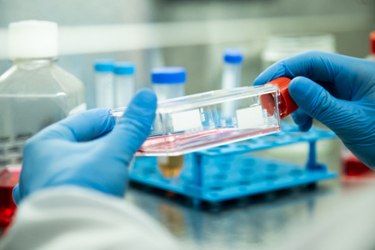Exploring Outsourcing's Role In CGT Scalability And Affordability
By Fahimeh Mirakhori, M.Sc., Ph.D.

Advanced biologics, such as cell and gene therapies (CGTs), administered either ex vivo or in vivo, have shown unprecedented promise in addressing previously untreatable conditions. Yet despite their clinical successes, their global accessibility remains constrained by a complex interplay of scientific, manufacturing, pricing, and policy challenges.
One of the main challenges for developers and policymakers is to strike a balance between incentives for innovation and strategies that facilitate broad patient access.
This is part 1 of a two-part article exploring outsourcing pharmaceutical development’s role in making advanced therapies more accessible. Click here for part 2.
CGTs diverge sharply from earlier generations of biologics, such as recombinant proteins or vaccines. Their highly variable starting materials, complex and personalized manufacturing steps, and the lack of fit-for-purpose tools for scalable production have limited both their clinical and commercial impact. Even a decade after their initial approvals, many CGTs have failed to achieve widespread accessibility due to the high cost and complexity of their production.1,2 In autologous treatments, for example, highly variable starting material and intricate multi-stage manufacturing workflows drive both delays and variability between batches. Meanwhile, traditional tools, such as manual cell culture or ultracentrifugation for virus purification, impede the scalability needed for global access.
To overcome these constraints, advances are required across three layers of innovation.
- First, automated, closed, and single-use platforms enable standardized, reproducible, and cost-effective processing across critical unit operations such as cell culture and viral vector purification.
- Second, sophisticated sensor technologies for process analytical technology (PAT) enable real-time monitoring of critical process parameters (CPPs), providing actionable data for early detection of batch variability and optimization.
- Third, digital technologies and platforms utilize these data to enable predictive process control, aligning critical quality attributes (CQAs) with patient-centric outcomes. Together, these advances are foundational to the shift toward an Industry 4.0 paradigm in CGT manufacturing, one that is distributed, automated, and knowledge-driven.3
The Role Of Outsourced Manufacturing And Regional Hubs
Unlike traditional small-molecule drugs, biologics are highly sensitive to manufacturing variations and require sophisticated characterization and quality controls. Even as advances in manufacturing platforms evolve, making CGTs accessible globally will require new business and supply chain strategies.
Outsourced manufacturing through CDMOs has emerged as a pivotal force in this space. CDMOs enable therapy developers, especially smaller biotech firms, to access state-of-the-art production platforms and expertise, without the massive up-front investment required for in-house manufacturing. By pooling resources and leveraging economies of scale, CDMOs help reduce the cost of goods and de-risk CGT commercialization, making treatments more viable across diverse patient populations and clinical settings.
Regional manufacturing hubs further enable cost-effective CGT production by aligning therapy supply with local or regional patient needs 4. The establishment of facilities like the United Kingdom’s Advanced Therapies Treatment Centres (ATTCs) has demonstrated how collaborative infrastructure can reduce bottlenecks in the supply chain and facilitate the transfer of technology and knowledge across stakeholders. Similar hubs are being developed across Europe, North America, and Asia, fostering a shift from centralized, high-cost production toward distributed, lower-cost manufacturing closer to the point of care.5
Policy Shift For Sustainable And Equitable CGT Access
While advances in manufacturing and regional hubs play a critical role in addressing supply constraints, achieving global access to CGTs also demands robust policy reforms. The Biologics Price Competition and Innovation Act (BPCIA) was introduced to establish a competitive pathway for biosimilars, similar to the Hatch-Waxman Act for small molecule generics.6-8 Yet, its implementation has been slower and less competitive than anticipated due to extended review times, complex patent litigation, and monopolistic IP practices. By extending lessons from the Hatch-Waxman era, reforms can be implemented to streamline review pathways, shorten market exclusivity periods, and reduce barriers posed by patent thickets.
High-profile examples underscore the urgency of this challenge. Advanced treatments, such as CAR-T products and Zolgensma, carry price tags of $373,000 to $2.1 million per patient.9-12 A Federal Trade Commission (FTC) study found that under the Hatch-Waxman Act, the entry of multiple generics reduced drug prices by up to 80%.10 In contrast, analyses of the Humaira case under BPCIA suggest a different dynamic faces significant regulatory and market challenges that hinder competitive price reductions. Similar price reductions are even more challenging for advanced CGT products due to their greater complexity in biostructure, design, development, and manufacturing. Thus, pricing policy reform is equally critical.
For example, Lenmeldy, a gene therapy for metachromatic leukodystrophy, was priced at $4.25 million for a one-time treatment.12 This raises serious concerns about affordability, especially for rare diseases, where treating just a few patients can cost millions.
Meanwhile, patients in low‑ and middle-income countries struggle to access even basic biologics, a disparity aggravated by fragmented pricing policies and IP protections. Additional measures include creating global licensing platforms for foundational CGT technologies such as adeno-associated virus (AAV) or CRISPR genome editors, making these platforms available to a wider range of developers. Limiting total market exclusivity to 12 years from the first FDA or EMA approval, expanding government march-in rights for publicly funded IP, and creating open patent pools for ultra-rare disease treatments can further reduce barriers, ensuring that CGTs benefit patients across borders, regardless of income or geography (Table 1).
Table 1: Examples of policy reform proposals for advanced therapies.
| Policy Proposal | Description | Impact Goal |
| Cap total exclusivity at 12 years. | Limit total market exclusivity (patent + regulatory) to 12 years from first FDA approval. | Prevent indefinite monopoly extension. |
| Ban patent thickets on foundational platforms. | Restrict the number of enforceable patents per product platform (e.g., vector + transgene). | Reduce anti-competitive barriers to entry. |
| Enforce march-in rights for publicly funded innovations. | Mandate licensing of NIH-funded or foundational CGT platforms like AAV, CRISPR, etc. | Ensure affordability and public return on investment. |
| Create an open licensing system for core technologies. | Mandate licensing of NIH-funded or foundational CGT platforms like AAV, CRISPR, etc. | Prevent monopolization of core research tools. |
| Launch a patent pool for ultra-rare conditions. | Establish a shared international patent pool for CGTs targeting ultra-rare diseases. | Enable shared development for unprofitable indications. |
Affordability and equity must be built into the CGT ecosystem from the ground up, aligning advances in manufacturing platforms with forward-thinking policies that strike a balance between innovation incentives and global access.13 The interplay between automated manufacturing, regional CDMO hubs, and digital technologies can dramatically reduce the cost and complexity of producing CGTs. These advances can be harnessed through pricing policies that emphasize patient benefit, such as value-based pricing, risk-sharing agreements, and tiered pricing for low‑ and middle-income nations.
To build a sustainable global CGT market, stakeholders must also focus on international collaboration and knowledge exchange. Programs like the WHO Access to Medicines initiative and the Coalition for Epidemic Preparedness Innovations (CEPI) demonstrate how multinational consortia can reduce costs and expand access across borders. Similar platforms can enable widespread access to CGTs, making treatments available regardless of geography.
The promise of CGTs to transform medicine rests not only on their scientific potential but also upon our collective ability to overcome the manufacturing and policy barriers that impede access. By aligning advances in automated manufacturing platforms, sensor-driven process controls, and digital twin modeling with robust IP reforms and global collaborative frameworks, the CGT field can evolve from a niche sector to a global cornerstone of medical care.14-16 Through a synthesis of technical innovation, strategic outsourcing, and forward-looking policies, CGTs can fulfill their promise, delivering life-changing treatments to patients across the globe, regardless of income, geography, or circumstance.
References:
- IAN HAYDON & THE CONVERSATION US. The Pricey Drugs Transforming Medicine. https://www.scientificamerican.com/article/biologics-the-pricey-drugs-transforming-medicine/: Scientific American Biologics 2017 [Accessed December 2024].
- Oldoni, E., Ussi A., Andreu A. L., Morrow D., It is time we got more personal with advanced therapies - How do we create the right ecosystem for more effective ATMP development in Europe? European Society of Medicine, https://doi.org/10.18103/mra.v11i9.4322 : Medical Research Archives 2023 [Accessed December 2024].
- Szarzynski A., Spadiut O., Reisbeck M., Jobst G., Paterson R.L., Kamenskaya A., Gateau E., Lesch H.P., Henry L., Kozma B. CGT 4.0: a distant dream or inevitable future? Smart process automation is critical to make efficient scalability of CGT manufacturing a reality. Frontiers in Bioengineering and Biotechnology. 2025; 13; doi: 10.3389/fbioe. 2025.1563878.
- U.K. National Institute for Healthcare and Excellence. NICE health technology evaluations: the manual: NICE process and methods 2023. [Available from: https://www.nice.org.uk/process/pmg36/resources/nice-health-technology-evaluations-the-manual-pdf-72286779244741. Accessed December 2024.]
- Cell and Gene Therapy Catapult. Annual Review. 2022. https://cgt.ams3.cdn.digitaloceanspaces.com/Catapult-Annual-Review-2022.pdf. [accessed 13.02.23].
- Simone A. Rose aTR. The Biosimilar Action Plan: An Effective Mechanism for Balancing Biologic Innovation and Competition in the United States? https://ssrn.com/abstract=3489444: SSRN, Wake Forest University; 2019 [Accessed December 2024].
- The U.S. Food and Drug Administration. “Deemed to be a License” Provision of the BPCI Act https://www.fda.gov/drugs/guidance-compliance-regulatory-information/deemed-be-license-provision-bpci-act: FDA; 2020 [Accessed December 2024].
- The Health Policy Today. Celebrating Hatch-Waxman’s Transformation of Prescription Access https://healthpolicytoday.org/2024/09/23/celebrating-hatch-waxmans-transformation-of-prescription-access/ Health Policy; 2024 [Accessed December 2024].
- Lovelace B., and Peebles A. FDA approves Novartis’ $2.1 million gene therapy — making it the world’s most expensive drug https://www.cnbc.com/2019/05/24/fda-approves-novartis-2-million-spinal-muscular-atrophy-gene-therapy.html: CNBC; 2019 [Accessed December 2024].
- The Federal Trade Commission. To Promote Innovation: The Proper Balance of Competition and Patent Law and Policy. https://www.ftc.gov/reports/promote-innovation-proper-balance-competition-patent-law-policy:; FTC, 2023 [Accessed December 2024].
- Choi G, Shin G, Bae S. Price and Prejudice? The Value of Chimeric Antigen Receptor (CAR) T-Cell Therapy. Int J Environ Res Public Health. 2022;19(19).
- Bansal A. Lenmeldy becomes world’s most expensive drug https://www.pharmaceutical-technology.com/analyst-comment/lenmeldy-becomes-worlds-most-expensive-drug/: Pharmaceutical Technology; 2024 [Accessed December 2024].
- Canter B, Sussman S, Colvill S, Arad N, Staton E, Rai A. Introducing biosimilar competition for cell and gene therapy products. Journal of Law and the Biosciences. 2024;11(2).
- Hopewell E, Pike NR, Lembong J, Hewitt M, Fekete N. Filling the gap: the workforce of tomorrow for CGT manufacturing as the sector advances. Cytotherapy. 2024 Jun;26(6):540-545. doi: 10.1016/j.jcyt.2024.03.007. Epub 2024 Mar 12. PMID: 38573277.
- Szarzynski A., Spadiut O., Reisbeck M., Jobst G., Paterson R.L., Kamenskaya A., Gateau E., Lesch H.P., Henry L., Kozma B. CGT 4.0: a distant dream or inevitable future? Smart process automation is critical to make efficient scalability of CGT manufacturing a reality. Frontiers in Bioengineering and Biotechnology. 2025; 13; https://doi.org/10.3389/fbioe.2025.1563878
- Pinto, E., Lione, L., Compagnone, M. et al. From ex vivo to in vivo chimeric antigen T cells manufacturing: new horizons for CAR T-cell based therapy. J Transl Med 23, 10 (2025). https://doi.org/10.1186/s12967-024-06052-3
About The Author:
 Fahimeh Mirakhori, MSc., PhD., PMP, is a professional strategist with 17-plus years of experience in life sciences and biotechnology. She is a consultant and educator who addresses scientific, technical, and regulatory challenges in cell and gene therapy (CGT), genome editing, regenerative medicine, and biologics product development. She has held diverse roles in the industry and academic settings, acquiring broad experience across various therapeutic modalities. Her expertise includes autologous and allogeneic engineered cell therapeutics (CAR-T, CAR-NK, iPSCs), viral vectors (AAV, LVV), regulatory CMC, and process and analytical development.
Fahimeh Mirakhori, MSc., PhD., PMP, is a professional strategist with 17-plus years of experience in life sciences and biotechnology. She is a consultant and educator who addresses scientific, technical, and regulatory challenges in cell and gene therapy (CGT), genome editing, regenerative medicine, and biologics product development. She has held diverse roles in the industry and academic settings, acquiring broad experience across various therapeutic modalities. Her expertise includes autologous and allogeneic engineered cell therapeutics (CAR-T, CAR-NK, iPSCs), viral vectors (AAV, LVV), regulatory CMC, and process and analytical development.
